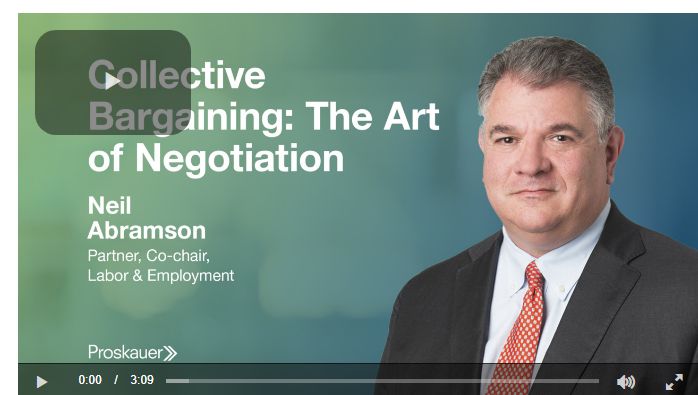Collective bargaining is a complex process that requires a nuanced approach. Partner Neil Abramson shares his perspective on effectively understanding the needs and concerns of our clients and negotiating an agreement that solves short-term needs and achieves long-term goals while fostering respect from unions and employees.
Transcript
Neil Abramson: Collective bargaining is an art form. It is highly nuanced. There are no hard and fast rules that you can reach for a buck and tell you what to do. The collective bargaining process in the United States is premised on the notion that there's going to be a continuing relationship between the bargaining parties. What I enjoy about this is anticipating the problems that are going to come up and dealing with them or establishing the framework of dealing with them now so the employer has as many tools as is possible - but also to work directly with their employees and understand the needs and the concerns of their employees.
Collective bargaining has transcended just wages. It's about, am I going to have a pension; am I going to have health benefits? What happens if I retire and get sick? All of those issues that are at the forefront these days require fairly complicated solutions.
"Collective bargaining has transcended just wages."
Neil Abramson, Partner, Labor & Employment
It's very important when you are sitting across from the bargaining table that you understand the power of rejection and the power of rejecting words. There are a lot of different ways to say "No" to the person who is sitting across the table from you. But it is the way that you say no that allows them to go back to their own bargaining committee and say, they disagree with us but you know they make a good point. They disagree with us but they are open to discuss potential solutions. One aspect of it is - don't be rude, don't be unnecessarily ad hominem by attacking anyone individually across the table. Don't make a promise that you're not going to keep, and the promises that you make? Be very careful. Make sure you can bring those to fruition because the worst thing you can be in collective bargaining is somebody who talks a good game across the table but then can't come through on what they say they are going to be able to do.
The easiest solution is not necessarily the best solution. You need to work very closely with your clients in order to determine not only what is going to solve their problem today, but what problems they may face a week from now, a year from now, five years from now, and anticipate those. Because it's only that way that you'll be just as proud walking into a Christmas party with the fellow employees that you've been negotiating against as you will be walking into a boardroom and explaining how you achieved this significant collective bargaining agreement for them going forward.
Collective Bargaining: The Art of Negotiation
The content of this article is intended to provide a general guide to the subject matter. Specialist advice should be sought about your specific circumstances.


